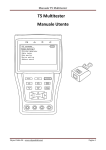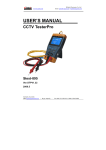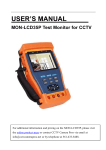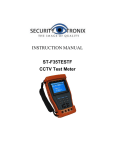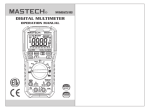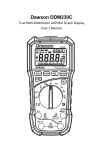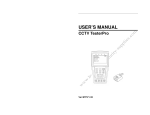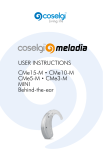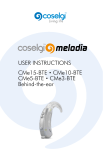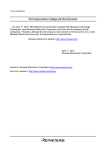Download User Manuals
Transcript
OPERATING INSTRUCTION AC/DC DIGITAL CLAMP METER CMP-2000 SONEL S. A. ul. Wokulskiego 11 58-100 Świdnica Version 1.02 03.04.2014 2 OPERATING INSTRUCTION CMP-2000 version 1.02 CONTENTS 1 INTRODUCTION ..........................................................5 2 UNPACKING AND INSPECTION ....................................5 3 SAFETY PRECAUTIONS ................................................5 4 SAFETY INFORMATION ...............................................6 5 INSTRUMENT LAYOUT ................................................8 6 AUTO POWER OFF (APO) ..........................................11 7 HOW TO MAKE MEASUREMENTS .............................11 7.1 7.2 7.3 7.4 7.5 7.6 7.7 7.8 7.9 VOLTAGE MEASUREMENTS ............................................. 11 CURRENT MEASUREMENTS ............................................. 13 RESISTANCE MEASUREMENTS.......................................... 13 CONTINUITY MEASUREMENTS ......................................... 14 DIODE TESTS................................................................ 14 CAPACITANCE MEASUREMENTS ....................................... 14 TEMPERATURE MEASUREMENT ....................................... 15 FREQUENCY MEASUREMENT ........................................... 15 % DUTY CYCLE MEASUREMENT ........................................ 15 8 SPECIFICATION .........................................................15 9 MAINTENANCE .........................................................19 10 REPLACING THE BATTERY .........................................19 OPERATING INSTRUCTION CMP-2000 version 1.02 3 4 OPERATING INSTRUCTION CMP-2000 version 1.02 1 Introduction This manual contains information and warnings which must be followed to ensure safe operation and retain the meter in safe condition. WARNING! Read "Safety information" before using the meter. This clamp meter is a handheld 6600-count instrument that is designed for use in the laboratory, field servicing, at home, and any circumstance where high current measurement is required. The clamp meter is built with a design of finger guard which ensures users operating the instrument under a safety situation; a rugged case that is shock resistant and fire- retardant; and electronic overload protection for all functions and ranges. In addition, a carrying case (optional accessory) is available for easy portability of the meter and avoiding damage. 2 Unpacking and inspection Upon removing your new Digital Clamp Meter (DCM) from its packing, you should have the following items: 1. Digital clamp meter. 2. Test lead set (one black, one red). 3. 9-Volt battery (installed in meter). 4. Type-K thermocouple. 5. Instruction manual. 6. Carrying case. If any of the above items are missing or are received in a damaged condition, please contact the distributor from whom you purchased the unit. 3 Safety precautions The following safety precautions must be observed to ensure maximum personal safety during the operation, service and repair of this meter: OPERATING INSTRUCTION CMP-2000 version 1.02 5 1. Read these operating instructions thoroughly and completely before operating your meter. Pay particular attention to WARNINGS which will inform you of potentially dangerous procedures. The instructions in these warnings must be followed. 2. Always inspect your meter, test leads and accessories for any sign of damage or abnormality before every use. If any abnormal conditions exist (broken test leads, cracked cases, display not reading, etc.), do not attempt to take any measurements. 3. Do not expose the instrument to direct sun light, extreme temperature or moisture. 4. Never ground yourself when taking electrical measurements. Do not touch exposed metal pipes, outlets, fixtures, etc., which might be at ground potential. Keep your body isolated from ground by using dry clothing, rubber shoes, rubber mats, or any approved insulating material. 5. To avoid electric shock use CAUTION when working with voltages above 40 Vdc or 20 Vac. Such voltages pose a shock hazard. 6. Never exceed the maximum allowable input value of any function when taking a measurement. Refer to the specifications for maximum inputs. 7. Never touch exposed wiring, connections or any live circuit when attempting to take measurements. 8. Do not attempt to operate this instrument in an explosive atmosphere (i.e. in the presence of flammable gases or fumes, vapor or dust). 9. When testing for the presence of voltage, make sure the voltage function is operating properly by reading a known voltage in that function before assuming that a zero reading indicates a novoltage condition. Always test your meter before and after taking measurements on a known live circuit. 10. Calibration and repair of any instrument should only be performed by qualified and trained service technicians. 11. Remember: Think Safety, Act Safely. 4 Safety information Cleaning Wipe the case with a damp cloth and mild detergent. Do not use corrosives or solvents. Dirt or moisture in the terminals can affect readings. 6 OPERATING INSTRUCTION CMP-2000 version 1.02 Safety: Conforms to IEC 61010-1 (EN 61010-1), IEC 61010-2-032 (EN 61010-2-032), CAT III 1000V, CAT IV 600V, Class II, Pollution degree 2 Indoor use. Degree of housing protection acc. to EN 60529: IP20. EMC: Conforms to EN 61326-1: 2006 The symbols used on this instrument are: Dangerous voltage Caution, refer to accompanying documents Urządzenie chronione podwójnąbyizolacją Equipment protected throughout Doub(klasa II) le insulation (Class II) Alternating current Direct current Ground OPERATING INSTRUCTION CMP-2000 version 1.02 7 5 Instrument layout 8 OPERATING INSTRUCTION CMP-2000 version 1.02 1. VΩHz% Voltage, Ohms, Frequency, % Duty cycle, Capacitance, Diode Input Terminal This is the positive input terminal for Voltage, Ohms, Frequency, Duty cycle, Capacitance, Diode measurements. Connection is made to it using the red test lead. 2. COM Common Terminal This is the negative (ground) input terminal for all measurement modes except current. Connection is made to it using the black test lead. 3. Temperature Input Jacks Remove test leads and slide TEMP switch to the right to close lead jacks. 4. Display The display indicates the measured value of a signal, function mode, and statement. 5. Ω/ / Shift: Ω 6. ZERO Button ranges. Button On the DC current ranges, the ZERO button works as the zero mode. Press ZERO button for more than 2 seconds to exit. On other functions, the ZERO button works as the relative mode. Press REL button again to exit the mode. In the Relative mode, the value shown on the LCD is always the difference between the stored reference value and the present reading. For example, if the reference value is 24.00V and the present reading is 12.50V, the display will indicate -11.50V. If the new reading is the same as the reference value, the display will be zero. OPERATING INSTRUCTION CMP-2000 version 1.02 9 7. Function/Range selector rotary switch This rotary switch selects the function, and selects the desired range. 8. INRUSH Button The INRUSH function captures the starting current precisely in the beginning of 100-millisecond period when current is just started. The INRUSH function is used in the A AC range. 1. Press the INRUSH button to toggle in the INRUSH mode, and the "----" and "INRUSH" will be displayed. 2. Press the trigger to open transformer jaws and clamp onto single conductor only, and turn on the meter. 3. Read the INRUSH current directly from the display. 4. Depress the INRUSH button for more than 2 second to exit the INRUSH mode. 5. Minimum input range: >100 dgts. 6. The readings of INRUSH measurements will show on the subdisplay. 7. Sampling frequency is 6x/100ms (60Hz). 9. MAX/MIN Button The "MAX" displays the maximum value of measurements. The "MIN" displays the minimum value of measurements. Press MAX/MIN button for more than 2 seconds to exit. The recorded value of MAX/MIN function will show on the sub-display, and the value being measured will show on the main-display. 10. Backlight Button Press the ond. button to activate the backlight for approximately 60 sec- 11. HOLD Button Press HOLD button to toggle in and out of the Data Hold mode. In the data hold mode, the "HOLD" statement is displayed and the last read10 OPERATING INSTRUCTION CMP-2000 version 1.02 ing is held on the display. Press HOLD button again to release the hold and current readings are once again displayed. 12. Trigger Press the lever to open the transformer. When the lever is released, the jaws will close again. 13. Transformer jaws Pick up the AC or DC current flowing through the conductor. The "+" marking on the jaw indicates direction of DC current existing on the conductor being tested which follows forward and vertically with jaws, and reading shown on display is positive. 6 Auto Power off (APO) Auto Power off: approx. 30 minutes. The meter will generate sounds before power off. After auto power off, press any button to restart the meter, and the reading of measurement will be maintained in the display. Cancellation Of Auto Power Off Feature: Press and hold the (MAX/MIN) button while rotating function switch from off to any position to turn the meter on. The auto power off feature is disabled. "APO" statement is missing from the LCD. 7 How to make measurements Before making any measurements read safety precautions. Always examine the instrument and accessories used with the instrument for damage, contamination (excessive dirt, grease, etc.) and defects. Examine the test leads for cracked or frayed insulation and make sure the lead plugs fit snugly into the instrument terminals. If any abnormal conditions exist, do not attempt to make any measurements. 7.1 Voltage measurements 1. Set the Function/Range switch to the V~/V position. OPERATING INSTRUCTION CMP-2000 version 1.02 11 WARNING! To avoid possible electric shock, instrument damage and / or equipment damage, do not attempt to take any voltage measurements if the voltage is above 1000V DC/750V AC. 1000V DC and 750V AC are the maximum voltages that this instrument is designed to measure. The "COM" terminal potential should not exceed 500V measured to ground. 2. Plug the black test lead into the “COM” input jack on the meter. 3. Plug the red test lead into the “VΩ” input jack on the meter. Voltage is always measured in parallel across a test point. 4. Connect the test leads to the circuit /device to be measured and make the voltage measurement. 5. After completing the measurement disconnect the meter test leads. 12 OPERATING INSTRUCTION CMP-2000 version 1.02 7.2 Current measurements WARNING! These Snap-Arounds are designed to take current measurements on circuits with a maximum voltage difference of 500V AC between any conductor and ground potential. Using the SnapAround for current measurements on circuits above this voltage may cause electric shock, instrument damage and/or damage to the equipment under test. Before measuring current make certain that the test leads are removed from the instrument. The Snap-Around is overload protected up to 500V AC for up to 1 min. Do not take current readings on circuits where the maximum current potential is not known. Do not exceed the maximum current that this instrument is designed to measure. 1. Set the Function/Range switch to the A~/A position. 2. Press the trigger to open the transformer jaws and clamp them around a conductor. Jaws should be completely closed before taking a reading. 3. The most accurate reading will be obtained by keeping the conductor across center of the transformer jaws. 4. The reading will be indicated on the main display. 5. Reduce the range setting if set too high until a satisfactory best resolution reading is obtained. 7.3 Resistance measurements 1. Set the Function/Range switch to the "Ω" position. 2. Turn off power to the circuit under test. External Voltage across the components causes invalid reading 3. Connect the red test lead to the "VΩ" jack and the black test lead to the „COM" jack. 4. Connect the test leads to the points of measurements and read the value from the display. OPERATING INSTRUCTION CMP-2000 version 1.02 13 7.4 Continuity measurements 1. Set the Function/Range switch to the position. Use the Ω/ / , to select the continuity test. 2. Turn off power to the circuit under test. External Voltage across the components causes invalid reading. 3. Connect the red test lead to the "VΩ" jack and the black test lead to the „COM" jack. 4. Connect the test leads to the two points at which continuity is to be tested. The buzzer will sound if the resistance is less than approximately 30Ω. 7.5 Diode tests 1. Set the Function/Range switch to the " " position. Use the Ω/ / button twice to select the diode test. 2. Turn off power to the circuit under test. External voltage across the components causes invalid readings. 3. Connect the red test lead to the "VΩ" jack and the black test lead to the „COM" jack. 4. Touch probes to the diode. A forward-voltage drop is about 0.6V (typical for a silicon diode). 5. Reverse probes. If the diode is good, "OL" is displayed. If the diode is shorted, "0.00" or another number is displayed. 6. If the diode is open, "OL" is displayed in both directions. 7. Audible Indication: Less than 0.03V. 7.6 Capacitance measurements 1. Set the Function/Range switch to the " " position. 2. Connect the red test lead to the "VΩ" jack and the black test lead to the "COM" jack. 3. Discharge the capacitor before taking capacitance measurements. 4. Touch the probes to the capacitor. Observe polarity when measuring polarized capacitors. 5. Read the capacitance directly from the display. 6. The meter has a residual capacitance in the 6.6nF and 660nF ranges, which is a normal status. Before taking measurements, press the ZERO button to zero the residual capacitance. 14 OPERATING INSTRUCTION CMP-2000 version 1.02 7. When the capacitor to be tested is connected, if "dIS.C" symbol indicates on LCD, it means there is voltage existing in the tested capacitor and to be discharged before testing. 7.7 Temperature measurement 1. Set the Function/Range switch to the "Temp" position. 2. Remove leads and slide TEMP switch to the right to close lead jacks. 3. Plug K-type thermocouple directly into the meter to measure temperature. 4. Take temperature measurement using the thermocouple probe and read the temperature from the display. 7.8 Frequency measurement 1. Set the Function/Range switch to the „Hz/%" position. 2. Connect the red test lead to the "VΩ" jack and the black test lead to the "COM" jack. 3. Connect the test leads to the point of measurement and read the frequency from the main display. 7.9 % duty cycle measurement 1. Set the Function/Range switch to the „Hz/%" position. 2. Connect the red test lead to the "VΩ" jack and the black test lead to the "COM" jack. 3. The readings of % duty cycle measurements will show on the subdisplay. 8 Specification Display: 6600 counts, 66 segments analog bar-graph. Polarity: Automatic, (-) negative polarity indication. Overrange Indication: (OL) or (-OL) is displayed. Low Battery Indication: the is displayed when the battery voltage drops below accurate operating level. Measurement Rate: 2.8x/sec, nominal. 28x/sec, analog bargraph. OPERATING INSTRUCTION CMP-2000 version 1.02 15 Operating Environment: 0°C to 50°C at < 70% R.H. Storage Environment: -20°C to 60°C at < 80% R.H. Temperature Coefficient: 0.1 x (specified accuracy) / °C (< 18°C or > 28°C). Auto Power Off: 30 minutes after rotary switch or mode changes. Altitude: 2000m. Power: Standard 9-volt battery. Battery Life: 75 hours typical with carbon-zinc battery. Jaw Opening Capability: 57mm conductor, 70 x 18mm bus bar. Size (H x W x D): 281 x 108 x 53 mm. Weight: Approx. 570g grams (including battery). Accuracy is given as ±([% of reading]+[number of least significant digits]) at 18°C to 28°C, with relative humidity up to 70%. DC Voltage Range Resolution Accuracy 660mV 0,1mV ±(0,5% rdg + 2d) 6,6V 1mV ±(0,5% rdg + 2d) 66V 10mV ±(0,5% rdg + 2d) 660V 100mV ±(0,5% rdg + 2d) 1000V 1V ±(0,5% rdg + 2d) Overload protection: 1000V DC or 750V AC rms. Input impedance >100MΩ 10MΩ 9,1MΩ 9,1MΩ 9,1MΩ AC Voltage (True RMS) Range Resolution Accuracy Input impedance >100MΩ 10MΩ 9,1MΩ 9,1MΩ 9,1MΩ 660mV 0,1mV ±(1,5% rdg + 8d) 50...100Hz 6,6V 1mV ±(1,5% rdg + 8d) 50...500Hz 66V 10mV ±(1,5% rdg + 8d) 50...500Hz 660V 100mV ±(1,5% rdg + 8d) 50...500Hz 750V 1V ±(1,5% rdg + 8d) 50...500Hz Crest Factor: ≤3. AC coupled true rms specified from 5% to 100% of range. Frequency ranges: 50Hz ~ 1kHz. Accuracy of f: ±(0.1% rdg + 5 dgts). The readings of frequency measurements will show on the subdisplay. 16 OPERATING INSTRUCTION CMP-2000 version 1.02 Minimum Input voltage Range: >500dgts. Overload protection: 1000V DC or 750V AC rms. AC current (True RMS) Range Resolution 600A 0,1A 1500A 1A Accuracy 0...660A ±(2,0% rdg + 10d) 50...60Hz 0...660A ±(3,0% rdg + 10d) 61...400Hz 660...1000A ±(2,5% rdg + 10d) 50...60Hz 660...1000A ±(3,5% rdg + 10d) 61...400Hz 1000...1500A ±(5,0% rdg + 10d) 50...400Hz Crest Factor: ≤3. AC coupled true rms specified from 5% to 100% of range. Frequency ranges: 50Hz ~ 1kHz. Accuracy: ±(0.1% rdg + 5 dgts). The readings of frequency measurements will show on the sub-display. Minimum Input current Range: >500dgts. Overload protection: 1500A AC. DC current Range 600A 2000A Resolution 0,1A 1A Accuracy 0...660A ±(2,0% rdg + 5d) 660...1000A ±(3,0% rdg + 5d) 1000...2000A ±(5,0% rdg + 5d) Overload protection: 2000A DC for 60 seconds maximum. Resistance Range Resolution 660Ω 0,1Ω 6,6kΩ 1Ω 66kΩ 10Ω 660kΩ 100Ω 6,6mΩ 1kΩ 66MΩ 10kΩ Overload protection: 600V Accuracy ±(1,0% rdg + 5d) ±(1,0% rdg + 5d) ±(1,0% rdg + 5d) ±(1,0% rdg + 5d) ±(2,0% rdg + 5d) ±(3,5% rdg + 5d) DC or AC rms. Open Circuit Voltage -3,2V d.c. -1,1V d.c. -1,1V d.c. -1,1V d.c. -1,1V d.c. -1,1V d.c. Continuity test Range Audible Threshold Response Time Open Circuit Voltage 660Ω Less than 30Ω Approx. 100ms -3,2V d.c. OPERATING INSTRUCTION CMP-2000 version 1.02 17 Diode test Range Resolution 2V 1mV Accuracy ±(1,5% rdg + 5d) Test Current 0,8mA Capacitance Range Resolution 6,6nF 1pF 66nF 10pF 660nF 100pF 6,6μF 1nF 66μF 10nF 660μF 100nF 6,6mF 1μF Overload Protection: 600V DC or AC rms. Temperature Range Open Circuit Voltage 3,2V d.c. typical Accuracy ±(3,0% rdg + 30d) ±(3,0% rdg + 10d) ±(3,0% rdg + 30d) ±(3,0% rdg + 10d) ±(3,0% rdg + 10d) ±(3,0% rdg + 10d) ±(5,0% rdg + 10d) Resolution Accuracy ±(1,0% rdg + 0...400°C 1°C 2°C) ±(2,0% rdg + -20...0°C, 400...1000°C 1°C 3°C) ±(1,0% rdg + 32...750°F 1°F 4°F) ±(2,0% rdg + -4...32°F, 750...1832°F 1°F 6°F) Overload protection: 60V DC or 30V AC rms. Sensor type K-type thermocouple Frequency Range Resolution Accuracy Trigger Level >3,2V >3,2V >3,2V >3,2V >3,2V >3,2V 66Hz 0,01Hz ±(0,1% rdg + 5d) 660Hz 0,1Hz ±(0,1% rdg + 5d) 6,6kHz 1Hz ±(0,1% rdg + 5d) 66kHz 10Hz ±(0,1% rdg + 5d) 660kHz 100Hz ±(0,1% rdg + 5d) 1MHz 1kHz ±(0,1% rdg + 5d) Minimum Input Range: >10Hz. Minimum pulse width: >1us. 18 OPERATING INSTRUCTION CMP-2000 version 1.02 Duty cycle limits: >30% and <70%. Overload protection: 600VDC or AC rms. % Duty Cycle Range Resolution Pulse width Accuracy ( 5V logic) 5...95% 0,1% >10μs ±(2,0% rdg + 10d) Frequency range: 5% to 95% (40Hz to 20kHz). The readings of % duty cycle measurements will show on the subdisplay. Overload protection: 600V DC or AC rms. 9 Maintenance Maintenance consists of periodic cleaning and battery replacement. The exterior of the instrument can be cleaned with a dry clean cloth to remove any oil, grease or grime. Never use liquid solvents or detergents. Repairs or servicing not covered in this manual should only be performed by qualified personnel. 10 Replacing the battery WARNING! To avoid electrical shock, disconnect the test leads and any input signals before replacing the battery. Replace only with same type of battery. This meter is powered by a 6LR61 (or 6F22, NEDA type 1604 or equivalent 9-volt battery). When the meter displays the , the battery must be replaced to maintain proper operation. Use the following procedure to replacing the battery: 1. Disconnect test leads from any live source, turn the rotary switch to OFF, and remove the test leads from the input terminals. OPERATING INSTRUCTION CMP-2000 version 1.02 19 2. The battery cover is secured to the bottom case by a screws. Using a Phillips-head screwdriver, remove the screws from the battery cover and remove the battery cover. 3. Remove battery and replace with a new equivalent 9-volt battery. 4. Replace the battery cover and reinstall the screws. 20 OPERATING INSTRUCTION CMP-2000 version 1.02























